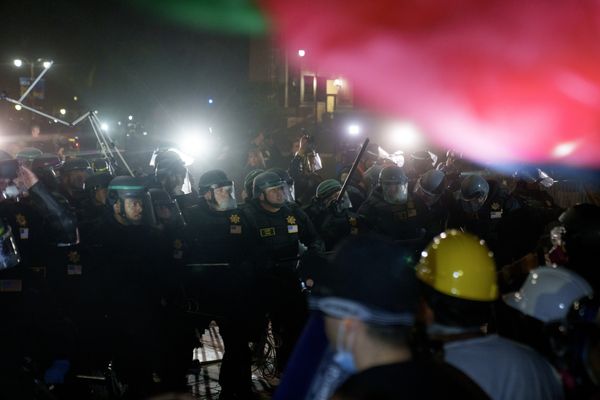The year was 1986. A natural calamity hit Sannati village in Kalaburagi district and partially destroyed the Chandralamba temple complex. While clearing the debris, the villagers found that the idol of Kali, their deity, was damaged in the calamity. They decided to replace the damaged idol with a new one. While removing the idol, they found some words etched on the Panipeetha, the base slab, of the idol. The curious villagers contacted historians who deciphered inscriptions written in the Prakrit language using the Brahmi script.
It turned out to be a 2000-year-old Ashokan edict. The inscription led the historians and archaeologists to an abandoned well at Kanaganahalli village on the bank of Bhima River located about 3 km from Chandralamba temple.
The discovery
The Archaeological Survey of India (ASI) began excavating the area in 1994 hoping to unearth more material of historical importance. Its efforts did not go in vain as its four-year excavation yielded historical marvels. The study of the material found in the excavation firmly established that the “abandoned well” was indeed the site of Adholoka Maha Chaitya [the Great Stupa of the Netherworlds] as it was referred to and described in many inscriptions and built in the Ashokan era.
The Maha Stupa, which measures nearly 22 meters in diameter and rose to a height of about 17 meters, is believed to have been developed in three constructional phases – Maurya, Early Satavahana and Later Satavahana periods -- stretching from 3rd Century B.C. to 3rd Century A.D. It is built with locally available limestone with elaborate ornamentation, Ayaka platforms in the cardinal directions and the circumambulatory path enclosed by a four-barred railing with entrances in cardinal directions.
Sculpture of the emperor
The excavation also recovered another precious stone of historical importance – a stone sculpture portraying Mauryan Emperor Ashoka. The emperor is seen surrounded by his queens and female attendants in this rare sculpture. The sculpture had the words “Raya Asoko” etched on it in Brahmi script leaving little scope for mistaking the identity of the man featured in it. While the Stupa is believed to be one of the largest Stupas built at the time, the stone portrait is considered to be the only surviving and available image of the Mauryan Emperor Ashoka.
The recoveries included around 60 dome slabs with sculptural renderings of selected Jataka stories, main events in the life of the Master, portraits of Shatavahana monarchs and certain unique depictions of Buddhist missionaries sent by Ashoka to different parts. There were 72 drum slabs decorated with a variety of Dharma-Chakras, Stupas, the first sermon, Bodhi-tree, Naga Muchulinda, and Viihara complexes. Also found were over 10 inscribed sculptures of the Buddha, over a dozen Buddha-Padas, fragments of Ayaka pillars, umbrella stones and shafts, parts of sculptures of Yakshas and lions and 250 Brahmi inscriptions with varied paleographical features.
It was a great discovery of the ASI that put Sannati and Kanaganahalli villages on the world map of archaeology attracting historians, archaeologists and researchers, apart from tourists, from across the world.
The apathy after
The Stupa was built with locally available limestone. Most of the dome slabs, drum slabs, inscribed sculptures and other structural remains were in broken states when they were retrieved. Some are broken into many pieces calling for greater care and conservation.
After the initial enthusiasm, the ASI appeared to have gradually developed apathy towards Kanaganahalli and Sannati sites for the next 15 years. Some heavy limestone sculpture panels retrieved in the excavations were kept in four tin sheds at the Kanaganahalli site. However, many more antiquities such as stone panels and pillars, smaller sculptures and decorative stone carvings of ruined Maha Stupa remained scattered in the open area getting exposed to sun, rains and gusty winds for many years. With mud and broken stone pieces in the inner portion of the drum structure and frequent water logging, the Maha Stupa once again became an “abandoned well.”
The worst thing was that even the sculpture-portrait of Emperor Ashoka which was considered to be the most important antiquity found in the excavation, was also kept in a small open shed with no protective cover, walls and railings around it. It was after Nikhil Das assumed office as the Superintending Archaeologist of Hampi Circle in September 2021 that the sculptor-portrait got a protective glass cover.
Karnataka government established Sannati Development Authority to conserve the antiquities retrieved in the excavation and develop the areas into a major tourist and pilgrimage destination. Karnataka Housing Board built a museum building, dormitories and staff quarters on the 18-acre spending ₹3.52 crores near the excavated site in 2009. However, the buildings are not handed over to ASI even 15 years after the construction. Abandoned for a long time without any maintenance, the building developed cracks and the entire premise turned out to be a wasteland full of weeds and thorny bushes.
The restoration project
Left largely in the lurch for 20 years after it came to light through the ASI excavations in the 1990s, the ancient Buddhist site on the bank of the Bhima River got a restoration project in 2022.
The ₹3.5 crore project envisioned the resetting of the remains of Maha Stupa to their original positions without much ornamentation and by reconstructing the fallen portions of the Ayaka platforms using newly fabricated bricks of the same size, shape and texture, wherever required, so that the better-preserved drum slabs could be repositioned in their original state.
Mr. Das says the project involves many stages of restoration and requires at least three years to be completed. The work commenced on July 6, 2022.
“Documentation and condition mapping process took a lot of time. We have adopted LiDAR (Light Detection and Ranging), an airborne laser scanning technology, to determine the original shape, size and position of the ruined structure. With the help of the detailed 3-Dimentional images provided by the LiDAR, we completed the condition mapping and structure determination process and started the restoration work,” Mr. Das told The Hindu.
Now the removal of core filling from the drum portion and the dismantling of the original structure is over. Since the surface of the landmass is made of loose black cotton soil, the engineers are presently working on strengthening the base to provide a solid foundation for the Stupa. Then comes the work of resetting the stone panels, rock slabs and pillars in their original position. Once the consolidation of the entire Stupa is done, the work on setting the railings and other periphery work will begin.
“Before proceeding to the next phase, we will organise a workshop involving archaeologists and engineers who are experts in restoring historical monuments. The workshop was supposed to be held in March, 2024. Because of the Lok Sabha elections, it is delayed by a couple of months,” Mr. Das said.
The potential
According to some ASI officials, the ancient Kanaganahalli Buddhist site is eligible to get the UNESCO World Heritage Site tag. The ASI and the state government need to work in coordination to realise the aim and put it on the Buddhist circuit of India.
Kalaburagi is already well-connected by rail, air and road. The State government should expand the connectivity and infrastructure of this ancient Buddhist site by developing better roads and tourist amenities. Equipped with better connectivity and civic amenities, the Sannati and Kanaganahalli may attract tourists from all over the world, especially from countries with sizable Buddhist populations like China, Thailand, Japan, Myanmar, Sri Lanka and Vietnam.






